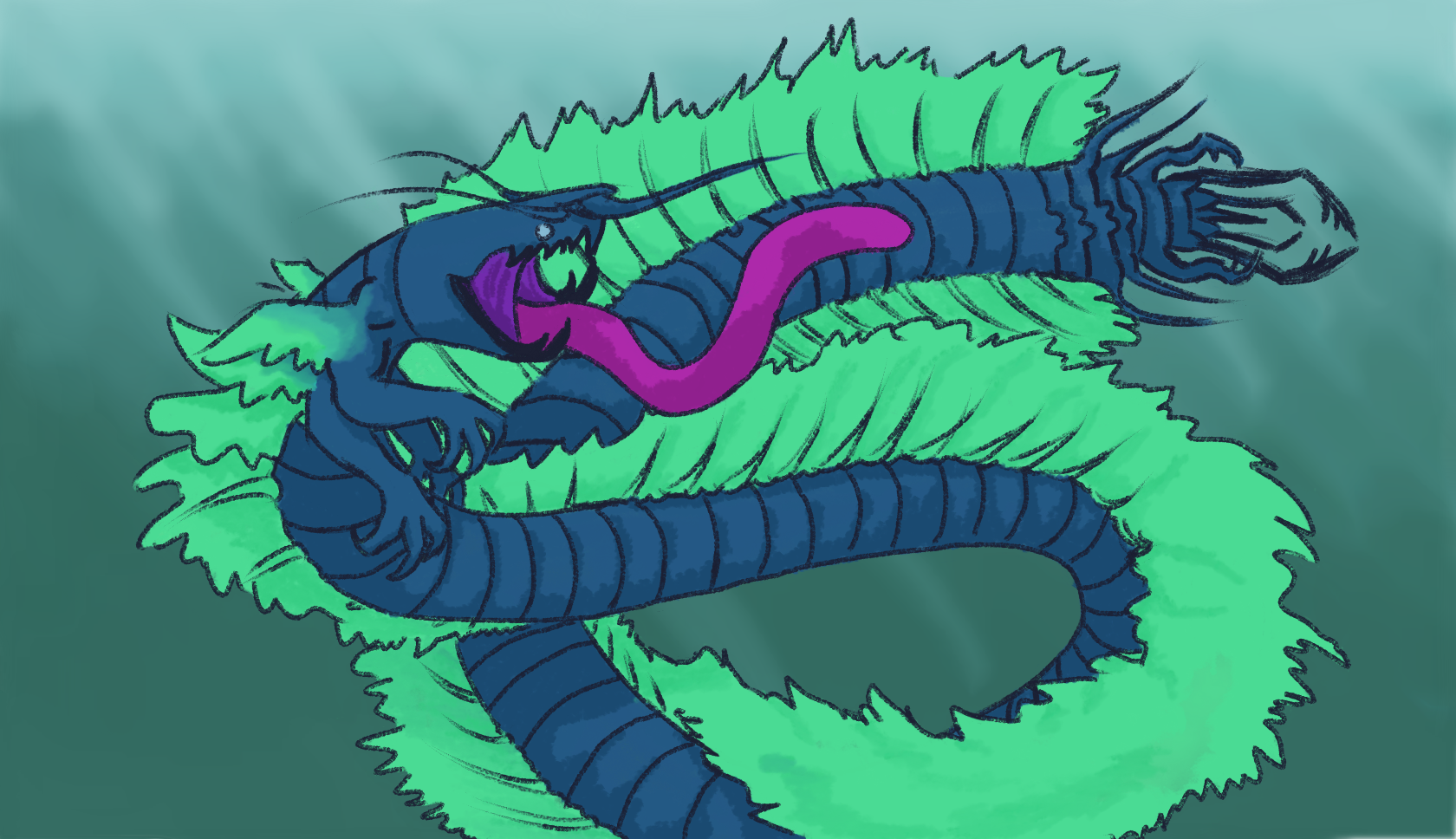Dreadful Lurkworm
Sliding in and out of subaquatic cave systems a slimy, frilled worm comes into view stalking a pod of unwitting dolphins. As they grow closer the worm contracts momentarily before suddenly everting its prehensile pharynx to capture its mark.
The remaining dolphins scatter as the worm works on engulfing its victim. However, the dolphin may not not be destined for this worms stomach, a much more grisly fate awaits.
Basic Information
Anatomy
The Dreadful lurkworm is a predatory Lurkworm that can grow upwards of 25 feet in length (7.62 meters) and 4 feet wide (2.22 meters), able to easily swallow most humanoids whole. They have one set of small eyes behind three large antennae and are colored darkly in blues and greens.
The "bristles" that cover the limbs they use to swim are capable of lighting up while displaying various territorial or courting behaviors.
Their mouth and entrails are colored bright purple or pink and they have a set of black or transparent feeding palps that act as jaws, along with a pharynx that they can turn inside out at high speeds to capture prey. It is reminiscent to a frogs tongue that has "teeth" which are same color as their palps and other spiny features on the subject.
The most unique physical feature is the Dreadful's four rudimentary arms that end in three clawed metacarpi that it can use to manipulate prey and objects.
At the end of its body is the tail section which holds its anus, several claw like Chaeta used for grasping creatures and terrain; Females have an ovipositor at the end of their body, a feature that is absent in the males.
Genetics and Reproduction
After a female Dreadful mates, she returns to her den, which may be completely secluded or near other females of her kind.
Dreadful Lurkworm dens are humid damp caves with large aerated portions and easy access to the ocean.
Upon returning she begins to redecorate; gnawing moss and scum off the walls and covering everything in her thick slime. Once this is finished she will hunt for 1 to 4 large or medium sized creatures to bring back to her den.
When a creature is brought back to the den it is regurgitated from a special sack and paralyzed with a venomous bite if it is not paralyzed already.
Then when she is finished she will wrap the creature in more slime and leave the eggs to incubate.
Incubation takes around 17 days, during which the mother will guard her brood.
The host is alive and partially conscious of its surroundings though numb and groggy through this process.
When the eggs hatch they will eat their eggshells immediately and begin to eat their way out of the host, after the host is completely consumed they will cannibalize one another. Typically only 6 out of every 100 hatchlings escape to the water, and only 1 out of 2 reach adulthood.
Ecology and Habitats
The Dreadful lurk worms habitat is mainly the dark underside of The Channel of Jewels and the coastal caves that exit into it.
Males once leaving their mothers den never return to land and spend the entirety of their remaining life underwater.
Females on the other hand maintain their own den that has Chambers full of air and solid ground for prey to be affixed to.
They are undoubtedly apex predators having no other animal that preys upon them in their natural habitat.
Dietary Needs and Habits
The Dreadful is an ambush predator sliding in and out of holes to attack unsuspecting prey. Their preferred prey are fish and marine mammals, sea-lions, dolphins, porpoises, iguana, sharks, humanoids; really, anything that gets too close when its hungry.
Additional Information
Uses, Products & Exploitation
Though truly horrifying the slime of Dreadful lurkworms has use as a salve that fights off infections in the flesh and repels most external parasites. The venom of the lurkworm is used to paralyze live animals, prisoners, and kidnapping victims.
Perception and Sensory Capabilities
Despite having eyes they are nearly blind and must compensate with other specialized senses.
They have the ability to track and identify unique scents with their antenna and a small organ inside their mouth.
To pinpoint creatures nearby they use a kind sensitive tissues lining their frills and limbs to "see" terrain and creatures.
This ability seems to be muddied by open expanses of water so they stick near to reefs and shorelines.
Art was done by myself, the Dreadful lurkworm in the picture is named Dr. Millicent Rollipolli Wurm.
Measurements are converted from feet to meters by a webpage and rounded up to the nearest hundredth
Conservation Status
While not seen commonly Dreadful lurkworms are not in any danger of going extinct they have no natural predators and though many sentient beings and more intelligent animals will kill it if it takes up residency nearby this is not related to feeding in any way and is instead linked to its gruesome manner of caring for its young.
Geographic Distribution



Comments